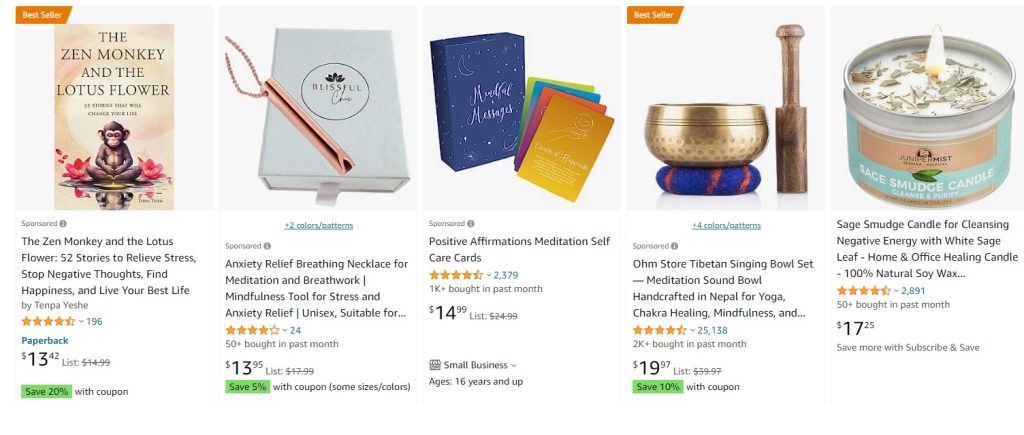Last Updated on September 26, 2023 by Avia
Do you ever feel like your mind is in a constant state of chaos? Or maybe you struggle with anxiety and stress on a daily basis? If so, maybe it’s time to consider trying breathwork as a solution to find some peace and clarity in your life. With different types of breathwork techniques available, each with unique benefits and outcomes, it can be difficult to know where to begin.
But fear not! I’ve utilized breathwork for decades, and I’ve learned a few things over the years. So, I thought I’d share some insights, explore different types of breathwork, what they do for the mind and body, how to do them, and why you should give them a try. So take a deep breath (literally), relax, and let’s dive into the world of breathwork together!
Table of Contents
- What Is Breathwork?
- What are the Benefits of Breathwork?
- Different Types of Breathwork and How to Do Them
- Tips for Beginners New to Breathwork
- Which Type of Breathwork is Best for Me?
- Frequently Asked Questions About Breathwork
- Conclusion

What Is Breathwork?
Breathwork is a term used to describe various techniques that focus on controlling the breath for therapeutic purposes. It involves conscious breathing practices aimed at enhancing physical, mental, and spiritual well-being. Breathwork can be done in different ways and has been practiced across many cultures throughout history.
At its core, breathwork recognizes the connection between our breath and our state of being. By regulating our breathing patterns, we can shift our energy levels and change how we feel physically and emotionally.
Some types of breathwork involve deep breathing exercises, while others incorporate visualization or meditation techniques to help individuals achieve a relaxed state of mind. Some forms of breathwork may also include intentional movement or sound to enhance their benefits.
The goal of breathwork is to tap into the power of your own body’s innate healing abilities through conscious control over your breathing patterns.
What are the Benefits of Breathwork?
Breathwork has numerous benefits for our physical, emotional, and mental harmony. Here are a few benefits of breathwork that may interest you.
Reduce Anxiety
One of the most significant health benefits associated with breathwork is that it can help to reduce stress and anxiety levels in the body. By taking slow, deep breaths and focusing on each inhale and exhale, we activate our parasympathetic nervous system, which relaxes us.
Enhances Mental Clarity
Breathwork also improves the clarity of mind by increasing oxygen flow to the brain. When we breathe deeply, more oxygen enters the bloodstream, which results in increased alertness and mental clarity. This can help us feel more focused throughout the day as well as improve memory retention.
It Can Help You Relax
Another benefit of breathwork is its ability to promote relaxation. Practicing deep breathing exercises on a regular basis can help lower blood pressure, decrease muscle tension, and relieve symptoms of insomnia or sleep apnea.
Enhances Overall Mood
Breathwork has been found to improve mood by releasing endorphins in the body which create feelings of happiness and euphoria. It’s a natural way to boost your overall sense of wellness while reducing negative emotions such as anger or frustration.

Different Types of Breathwork and How to Do Them
We’ve talked about the benefits of breathwork and what it is. I think we’ve also determined that Incorporating different types of breathwork into your daily routine offers many potential benefits for improving both physical health and emotional wellness. So, now let’s take a look at some different types of breathwork and how to do them so you can get started improving your life in remarkable ways just through using your breath.
Holotropic Breathwork
Holotropic breathwork is a type of deep breathing technique that was developed by Stanislav Grof and Christina Grof. This practice involves controlled, deep breathing for an extended period of time to induce altered states of consciousness.
The term “holotropic” comes from the Greek words holos, which means “whole,” and trepein, which means “to move towards” or “to turn around.” In essence, holotropic breathwork aims to help individuals move towards wholeness or integration by accessing deeper parts of their psyche.
How to Do Holotropic Breathwork
During a typical session, participants lie down on a mat with their eyes closed while listening to music specifically chosen to facilitate the experience. They then engage in rapid and deep breathing for anywhere from 30 minutes up to several hours. The process may also include bodywork or other forms of support.
One key aspect of holotropic breathwork is its focus on allowing whatever arises during the process without judgment or interpretation. Participants are encouraged not to analyze what they experience but rather to allow it to unfold naturally.
If you’re interested in trying out holotropic breathwork as part of your spiritual ritual, you might want to do so under guidance from qualified professionals who can ensure your safety throughout the process.
Shamanic Breathwork
This is one of my favorite practices because it opens up a sacred space and allows me to connect with nature, animals, and ancient energy. Shamanic breathwork is a powerful form of breathwork that combines therapeutic techniques and ancient shamanic practices to help individuals access higher states of consciousness.
This type of breathwork involves deep, rhythmic breathing for an extended period while lying down with music playing in the background. I like to burn sage or do smudging during shamanic breathing too.
During this process, participants may experience intense emotions, visuals, and physical sensations as their body releases stuck energy and trauma from the past. The goal is to access the subconscious mind, connect with spiritual guides or ancestors, and receive insight into one’s life path.
How to Do Shamanic Breathwork
To begin shamanic breathwork practice at home, find a comfortable space where you won’t be disturbed for at least an hour. Play some evocative music, such as sacred drumming, that resonates with you and set your intention for the session. Begin breathing deeply through your nose while expanding your belly on each inhale and contracting it on each exhale.
As you continue to breathe rhythmically, allow any emotions or physical sensations to arise without judgment or attachment. Trust whatever comes up during the journey, as it may hold valuable insights for personal growth.
Shamanic breathwork can be a transformative experience when done regularly over time. However, it’s important to work with a trained facilitator if possible since this type of breathwork can bring up intense emotions that require support and guidance from someone experienced in holding space for healing processes.

Yogic Breathing
Yogic breathing, also known as Pranayama, is a type of breathwork that originates from ancient Indian practice. It involves controlling the breath to improve physical and mental health. In my experience, yogic breathing can be extremely intense but also incredibly restorative.
One form of yogic breathing is Nadi Shodhana, or alternate nostril breathing. Start by covering one nostril and inhaling deeply through the other. Then switch nostrils and exhale slowly out of one while keeping the other closed.
Another form of pranayama is Kapalabhati, or skull-shining breath, which involves forceful exhalations followed by passive inhalations. This technique strengthens abdominal muscles and clears energetic blocks in our body’s channels called nadis.
How to Do Yogic Breathing
To begin practicing yogic breathing, find a comfortable seated position with your spine straight. Place your hands on your knees or in a mudra (hand gesture). Close your eyes and begin by taking slow deep breaths through the nose, filling up the lungs completely.
Next, exhale slowly through the nose while contracting the lower belly muscles. This is called Ujjayi breath or “ocean-sounding” breath due to its gentle wave-like sound. You can also synchronize your breathing while doing asanas (yoga positions).
Yogic Breathing can help reduce stress levels, increase lung capacity, and enhance concentration and focus. It also promotes relaxation and helps release tension from our bodies and minds giving us inner peace and calmness.
Deep Relaxation Breathing
Deep relaxation breathing, also known as diaphragmatic breathing or belly breathing, is a technique that can help reduce stress and anxiety. This type of breathwork involves engaging the diaphragm muscle to take deep, slow breaths from the abdomen rather than shallow chest breaths.
How to Do Deep Relaxation Breathing
To practice deep relaxation breathing, find a comfortable seated or lying position with your hands resting on your stomach. Inhale slowly through your nose, allowing the air to fill up your lungs and expand your belly. Hold for a few seconds before exhaling slowly through pursed lips while focusing on relaxing all the muscles in your body.
Repeat this process for several minutes until you begin to feel more relaxed and centered. It’s important to note that it may take some time to fully master this technique, so be patient with yourself and keep practicing regularly.
Incorporating deep relaxation breathing into daily life can have numerous benefits, including reducing stress levels and promoting overall well-being. So why not give it a try? Find a quiet space, close your eyes, and breathe deeply – you might just be surprised at how effective this simple technique can be!

Conscious Connected Breathing
Conscious connected breathing is a type of breathwork that focuses on deep, rhythmic breathing to help release emotional blocks and facilitate healing. This technique involves inhaling deeply through the nose and exhaling fully through the mouth in a circular motion without pausing between breaths.
How to Do Conscious Connected Breathing
During this process, it is important to maintain a steady rhythm so your body can gradually adjust to the increased oxygen flow. As you continue with conscious connected breathing, you may experience sensations such as tingling or warmth in your extremities, light-headedness, or even muscle cramps. So, please be mindful, or have an expert help you through your first few sessions.
It’s also essential to remain patient and trust the process during these moments because they are signs that energy is moving within you. You should not resist them but rather allow yourself to fully embrace them until they pass naturally.
Many practitioners have reported positive outcomes from using this method of breathwork, such as enhanced clarity and focus, reduced anxiety levels, improved sleep quality, and boosted immunity function, among others. It’s advisable for beginners seeking optimal results from this practice to work with an experienced practitioner who can guide them safely through each stage while keeping them motivated toward their goals.
Controlled Breathing
Controlled breathing is a technique that involves consciously manipulating the rate and depth of your breaths. It serves as an effective tool for reducing stress, anxiety, and managing certain medical conditions like asthma or chronic obstructive pulmonary disease (COPD). The practice consists of inhaling slowly through your nose, holding it for a few seconds, then exhaling deeply through your mouth.
How to Do Controlled Breathing
There are different ways to perform controlled breathing exercises; one popular method is the 4-7-8 technique. This involves inhaling for four counts through the nose, holding it in for seven counts, then exhaling slowly through the mouth for eight counts. Repeat this cycle four times until you feel calm and relaxed.
Another approach to controlled breathing is using visualizations, such as imagining yourself in a peaceful environment while focusing on your breath. You can also incorporate physical movements like stretching or yoga poses during each inhalation/exhalation cycle.
Adding controlled breathing exercises into daily rituals can provide numerous benefits, including reduced stress levels and improved respiratory function.

Rebirthing Breathwork
Rebirthing breathwork is a type of breathwork that uses conscious breathing to release tension and trauma stored in the body. This technique was developed by Leonard Orr, who believed that our birth experiences could have a profound impact on our emotional well-being. The goal of rebirthing is to access these buried emotions and memories, allowing us to heal and move forward with greater clarity.
How to Do Rebirthing Breathwork
To practice rebirthing breathwork, find a comfortable and quiet space where you won’t be disturbed for around an hour. Lie down on your back or sit up straight with your eyes closed. Begin by taking slow deep breaths in through the nose and out through the mouth.
As you breathe, focus on relaxing your body and letting go of any tension or stress you may be holding onto. Allow yourself to sink deeper into relaxation with each breath you take.
After a few minutes of deep breathing, begin to focus more specifically on any emotions or memories that come up for you. Don’t try to push anything away – instead, allow it all to surface naturally without judgment.
Continue this cycle of deep breathing followed by focused meditation for around 30-40 minutes before slowly coming back to reality with some gentle stretches or movements.
Remember that rebirthing can bring up intense emotions – if at any point during this exercise you feel overwhelmed or uncomfortable, please stop immediately. Here again, you may also want to practice this or other different types of breathwork with a trusted friend or with a breathwork practitioner.
Circular Breathing
Circular breathing is a technique that originated in ancient cultures and has been used for centuries to improve mental focus, reduce stress, and promote physical healing. This practice involves inhaling through the nose and exhaling through the mouth in a continuous, circular pattern without pausing between breaths.
How to Do Circular Breathing
To begin circular breathing, sit comfortably with your back straight and take a deep breath through your nose. As you exhale through your mouth, immediately begin inhaling again through your nose. Continue this cycle of inhalation and exhalation without any breaks or pauses between breaths.
As you become comfortable with the rhythm of circular breathing, focus on maintaining an even flow of air throughout each cycle. You may find it helpful to count each inhale and exhale to help stay focused.
Circular breathing can be especially beneficial for those who suffer from anxiety or stress-related conditions as it helps calm the mind by bringing attention solely on the breath. It can also aid in releasing tension held within muscles throughout the body.
Incorporating regular circular breathing into your daily routine can have numerous benefits for both physical health and emotional harmony.

Tips for Beginners New to Breathwork
If you’re new to breathwork, it’s important to remember that there is no right or wrong way to do it. It can take time and practice to find the type of breathwork that works best for you. Here are a few tips I learned in my practice using breathwork that might help you too
- One tip for beginners is to start with shorter sessions, around 10-15 minutes, and gradually work your way up as you become more comfortable with the practice. It’s also important to make sure you are in a quiet and comfortable space where you won’t be disturbed during your session.
- Another tip is to focus on your breathing and try not to get distracted by external thoughts or distractions. This can be easier said than done, but with practice, it becomes easier.
- Don’t worry if, at first, your mind wanders off during your session. Just acknowledge the thought without judgment and bring your focus back onto your breath.
- It’s also helpful before starting any type of breathwork session to set an intention for yourself. This could be anything from wanting greater relaxation or clarity in decision-making skills.
- Don’t hesitate to seek guidance from a qualified instructor who can help guide you through different types of breathwork techniques tailored specifically toward beginners.
Which Type of Breathwork is Best for Me?
When it comes to choosing the best type of breathwork, there is no one-size-fits-all answer. The ideal option for you will depend on your personal needs and goals. For instance, if you want to feel more relaxed and centered, deep relaxation breathing might be a good choice.
If you are looking to process past traumas or emotional baggage, rebirthing breathwork may be beneficial. Meanwhile, yogic breathing can help enhance physical health and fitness levels by increasing lung capacity and oxygen intake.
It’s also crucial to consider factors such as experience level and medical history when selecting a type of breathwork. Always consult with an experienced practitioner before starting any new practice or technique.
Ultimately, the best way to determine which type of breathwork is right for you is through trial-and-error experimentation until you find what resonates most with your mind-body-spirit connection.

Frequently Asked Questions About Breathwork
Now that we’ve covered a lot of different types of breathwork and how they work, hopefully, you have a better understanding of how this can be an ace practice to improve your life. But you might still have questions. If so, here are a few FAQs to further expound on breathwork.
Breathwork is generally considered safe, but it’s important to consult with a healthcare professional before starting any new breathing techniques, especially if you have a pre-existing medical condition.
The frequency of your breathwork practice can vary depending on the type of technique you are using and your personal preferences. Some people find daily or weekly sessions helpful, while others may only do it occasionally as needed.
While some types of breathwork can be done alone, it’s recommended to work with an experienced teacher when learning new techniques to ensure proper guidance and safety.
During a typical session, you may experience physical sensations such as tingling or warmth in the body, emotional release, and deep relaxation.
The duration of each session can vary depending on the specific technique being used and individual factors such as comfort level and experience with the practice. Some sessions can be a quick 10 minutes, whereas other more in-depth sessions could last hours.
Some people may experience temporary dizziness, lightheadedness, or feelings of discomfort during their initial sessions. However, these symptoms usually dissipate quickly once they become more familiar with the technique.
Children can safely participate in age-appropriate breathing exercises under adult supervision. However, different types of breathwork, such as yogic advanced pranayama, should only be practiced under the supervision of adults who have at least years’ worth of training first.
Remember that while many practitioners swear by its benefits – including increased mindfulness and inner peace – results will differ between individuals based upon various factors such as underlying health conditions (if any), lifestyle habits, etc.
Conclusion
Breathwork is a powerful practice that offers numerous health benefits to our physical, mental, and spiritual well-being. The different types of breathwork techniques discussed in this article provide various approaches to harnessing the power of our breath and improving our overall quality of life.
From holotropic breathwork to controlled breathing, each technique has its unique benefits and purpose. It’s essential to experiment with different practices until you find one that resonates with you.
And remember, before starting any breathwork practice, please consider seeking professional guidance from an experienced practitioner or physician if you have underlying medical conditions. Oh, and you should also know nothing in this article about the different types of breathwork is intended to replace any type of medical or mental health advice.
All that said, incorporating breathwork into your daily routine can be a transformative experience for anyone looking for more peace, relaxation, or clarity in their lives. So why not give it a try? Take some deep breaths now and let yourself feel the difference! As always, thanks for reading, and happy breathing!
Mighty brightly,

© Copyrighted. All Rights Reserved.








